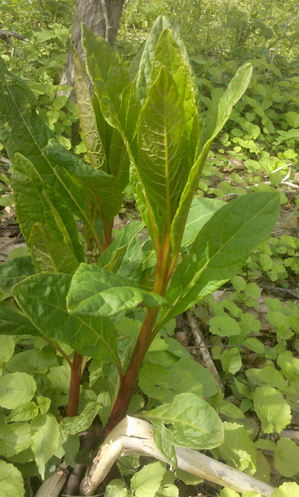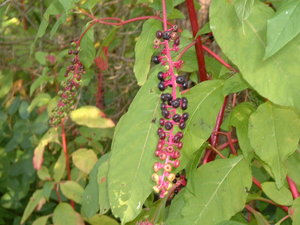Wildcrafting: Pokeweed is toxic, except for brief time in spring

Pokeweed can be used in spring salads. Every other time of the year, every part of the plant should be considered toxic.
Linda Diane Feldt | Contributor
In 1969 many music lovers heard about the plant poke for the first time in a song called “Polk Salad Annie,” written by Tony Joe White. The first part of the song described a weed harvested by a poor family that had troubles beyond hard living.
“If some of ya'll never been down South too much...
I'm gonna tell you a little bit about this, so that you'll understand
What I'm talking about
Down there we have a plant that grows out in the
woods and the fields,
looks somethin' like a turnip green.
Everybody calls it Polk salad. Polk salad.”
The full lyrics, including the familiar refrain “Polk salad Annie 'Gators got you granny” are available here. This dramatic purple tinged plant can grow as high as 10 feet, with large purple berries and beautiful long and wide reddish purple leaves.
Phytolacca Americana, commonly called poke or pokeweed, is a pervasive plant, with seeds strewn though bird droppings. Almost every part of the plant is toxic, especially the berries, except for a brief time in the early spring when the leaves can be safely eaten. If you eat the plant once it is mature its cathartic and purgative effects are powerful and dangerous. Birds eat the berries and pass the seeds through their digestive systems. If they had a way to chew the seeds, it might be a different fate for the birds.

Later in the year poke produces beautiful purple and toxic berries.
Linda Diane Feldt | Contributor
When the plant is small, a foot or less with tender new leaves, it has been used as a salad green in the south. It is lesser known in this area. As soon as it is just a bit larger, the risk of toxic effects increases.
Poke has many uses medicinally, including as a powerful immune system enhancer. It is a plant that is best used in consultation with an experienced herbalist or health care professional, certainly not something to try after reading a blog or even a simple Internet search. The most commonly used preparation, a tincture made from the root, is not usually available to lay people. The dosing traditionally begins with a single drop, building a drop at a time each day, until a maximum of 7-12, depending on the client.
Because the potency really matters with this plant, it isn’t a tincture that I’ve made for myself. I buy it from a company that carefully measures potency and ingredients. But even then, I had to have a personal interview with the president of one of the popular national herb companies before they would supply me with a bottle.
I had a bit of poke today, nibbling the tender new leaves. It was soft in texture and flavorful, and I could detect a slight spiciness to it. It has a full robust flavor, satisfying and a little exotic. Enjoy it now, and then wait until the next spring before you indulge again.
The song makes it sound as though Annie was harvesting poke all year-round, which is why you also shouldn’t entirely rely on pop songs for wild food advice either. I’ve known at least one person who is sorry that they did.
Linda Diane Feldt is a Holistic Health Practitioner, writer and teacher. Reach her at ldfeldt (at)holisticwisdom.org, through her website, and you can also follow her daily wildcrafting observations on twitter. A nearly complete compilation of her wildcrafting blogs is available online. There are three scheduled weed walks coming up soon as well as a free class on local medicinal herbs from 7-8:30 p.m. May 27 at Crazy Wisdom.


Comments
Vivienne Armentrout
Wed, May 19, 2010 : 8:40 p.m.
I grew up eating "poke salad" in Oklahoma. We laughed at the Yankees who thought it was an actual salad. We cooked it like a good southern green (some people discarded the water from a first boiling), with long cooking and bacon fat. Then a dash of vinegar from a bottle containing hot green peppers. My husband's aunt south of Kansas City picked poke greens in the spring and froze them to have the treat all year long. I always liked it, but my mother really explained the point. She said it was one of the first green things one could have in the spring and that tasted really good after a winter of not much in the way of green vegetables. I can't imagine eating it raw. I've seen it canned.
Teresa
Tue, May 18, 2010 : 9:18 a.m.
Thanks for this article! This plant was in the backyard of my parents house when I was a kid, but I never knew what it was. I guess it's a good thing we never ate it.